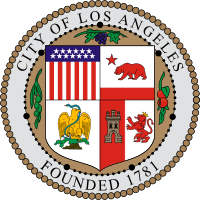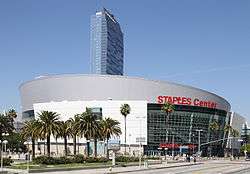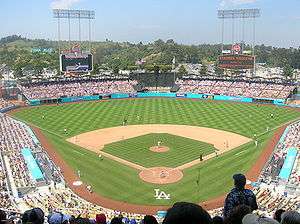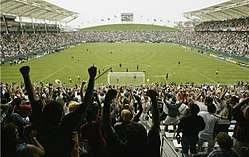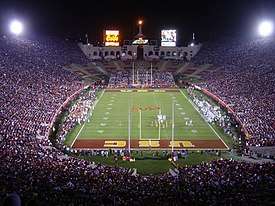UCLA–USC rivalry

The UCLA–USC rivalry refers to the American collegiate athletics rivalry between the UCLA Bruins sports teams of the University of California, Los Angeles (UCLA) and USC Trojans sports teams of the University of Southern California (USC). UCLA teams have won a total of 114 NCAA Division I championships. Only Stanford University, with 115, has more, while USC has the third most NCAA Division I-sanctioned team championships at 104.
Both universities are located in Los Angeles. The rivalry between the two is among the more unusual in National Collegiate Athletic Association (NCAA) Division I sports, because the campuses are only 12 miles (19 km) apart, and both are located within the same megacity.
Background
USC is recognized as consistently being one of the top football programs in the nation, while UCLA is recognized as consistently being one of the top basketball programs in the nation. However, a somewhat rare confluence of events occurred in 1954, which began with USC in their last of only two Final Four appearance in the 1954 NCAA Men's Division I Basketball Tournament and ended with UCLA winning their only Football National Championship.

Both schools also are successful in many "non-revenue" or "olympic" sports. Both have had success in track and field, water polo, tennis, volleyball, and golf. USC has won 26 NCAA Championships in Men's Outdoor Track and Field, 21 in Men's Tennis, and 12 in Baseball, the most of any school in each respective sport. Likewise, UCLA has won 19 NCAA Championships in Men's Volleyball, 11 in Softball, and 7 in Women's Water Polo, also the most of any school in those sports.
UCLA ranks second overall in NCAA team championships, with 115, behind Stanford, with 116. They also rank second in men's NCAA team championships with 72, and second (behind Stanford) in women's NCAA team championships with 39. USC ranks higher than UCLA and first in the nation in men's NCAA team championships with 84; it is 3rd overall with 104 NCAA titles (behind UCLA and Stanford) .[1] Both schools also have several non-NCAA Championships, including AIAW and pre-NCAA championships.
Gauntlet
The Lexus Gauntlet is the name given to a competition between UCLA and USC in the 18 varsity sports that both compete in head-to-head; in 2003, 2005, and 2007 UCLA won the Lexus Gauntlet Trophy, while USC won the trophy in 2002, 2004, 2006, 2008, and 2009 (the first back-to-back win). After the 2009 season, Lexus stopped sponsoring the award, and the winner has been tracked less formally. Since the end of the Lexus sponsorship, USC has won in 2010 and 2011. UCLA won in 2012, 2013, and 2014.[2][3][4][5][6]
Football rivalry
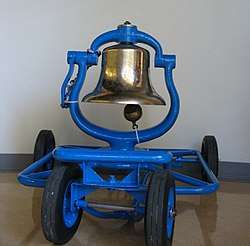
Quite often, the winner of the football game has won or shared the Pac-12 Conference (Pac-12) title in football. A berth in the Rose Bowl game has been on the line many times as well for both schools. Since the 1916 formation of the Pacific Coast Conference, which the Pac-12 claims as part of its history, USC has won or shared 37 conference titles and UCLA has won or shared 17 titles.[7] Washington is third in overall conference titles with 15.[7] Since the 1959 season, when the Pac-12 was formed as the Athletic Association of Western Universities, through the 2007 season, the schools have won or shared 33 of the 48 conference titles.[7] USC has won 17 championships outright, shared eight and gone to the Rose Bowl or BCS bowl 21 times.[7] UCLA has won six championships outright, shared five and gone to the Rose Bowl eight times.[7] The schools have thrice shared the championship.[7] In 2011, UCLA became the first Pac-12 South Division champion – while USC held the better of the two records, the Trojans were ineligible for postseason play that year due to NCAA sanctions. Both teams have spoiled conference and national championship runs for the other.
USC was a somewhat established national football power under Howard Jones and had begun a major rivalry with Notre Dame when UCLA joined the Pacific Coast Conference in 1928.[8] Los Angeles Times sportswriter Braven Dyer predicted on the day of the first football meeting on September 28, 1929, "In years to come, this game will probably be one of the football spectacles of the West" [9] USC dominated the early games (so much so, that after the first two games, the series was suspended for five years and they did not play each other from 1931 to 1935) until UCLA established itself.
By the late 1930s, star players such as Kenny Washington, Jackie Robinson, and Bob Waterfield enabled UCLA to be competitive. With the hiring of Hall of Fame Coach Henry "Red" Sanders, UCLA became the more dominant program in the 1950s with their one and only National Championship in 1954. A famous quote was attributed to Sanders regarding the rivalry, "Beating 'SC is not a matter of life or death, it's more important than that." [10][11]
But Sanders died suddenly of a heart attack, and shortly thereafter, one of the greatest colleges football coaches in NCAA history took over the struggling USC program. Upon the arrival of their new head coach John McKay (1960–1975), USC entered a new golden age in their storied history. During McKay's tenure, the Trojans won 8 conference titles, 5 Rose Bowls, produced two Heisman Trophy winners (Mike Garrett and O. J. Simpson) and won three National Championships (1962, 1967, and 1972) and shared one (1974). Against UCLA, McKay was tough to beat, posting a 10–5–1 record against the Bruins between 1960 and 1975.
For most seasons from the mid-1960s to the end of the 1970s, the two schools were the top powers on the West Coast with USC usually holding the top spot. In the 15 Rose Bowls played from 1966 to 1980, USC or UCLA played in 12 of them. Even with the rise of Don James' Washington Huskies in the 1980s and early 90s, UCLA or USC still went to the Rose Bowl seven times between 1981 and 1995. In the 1990s, UCLA enjoyed an eight-game winning streak against USC.
The Bruins' unbeaten string ended in 1999 when the Trojans began their longest win streak, 7, against the Bruins, though two of those wins (2004 and 2005) are now vacated, cutting the USC streak to five. This unprecedented dominance was the direct result of the hiring of Pete Carroll by USC in 2000. During Carroll's tenure (2001–2009 seasons), USC was virtually unbeatable against its two most heated rivals, UCLA and Notre Dame. The only game that UCLA beat a Pete Carroll-coached team was the 13–9 win in 2006 at the Rose Bowl that kept USC out of the BCS Championship game and allowed the Bruins to keep the record for consecutive wins (8) in the rivalry.
Title of the game
A number of titles have been applied to the football game such as: "The Los Angeles City Championship", "The Crosstown Showdown", "The Battle of L.A.", or simply the "crosstown rivalry". But none really have gained traction. Most often the game is referred to as the USC-UCLA (or UCLA-USC) football game by the media.[12] Fans of a particular team refer to it as the USC game or UCLA game, using the name of the opposing school.
Activities before the game
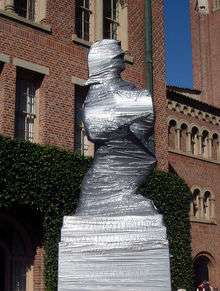
At UCLA, the week before the game is known as "Beat 'SC Week" (officially dubbed "Blue and Gold Week"). At USC, the week before the game is known as "Troy Week" or, more popularly, "Conquest".
Both schools host a number of activities on their respective campuses during the week to promote school spirit. Activities include parades, bonfires, rallies, and live entertainment.
Also, both schools take steps to prevent vandalism of two major landmarks on campus: USC wraps its Trojan Shrine (better known as "Tommy Trojan") in bubble wrap and duct tape, while UCLA covers its Bruin Bear statue with tarp stating "THE BRUIN BEAR IS HIBERNATING. BEAT 'SC.", and more recently a $5000 wooden puzzle box. Groups of UCLA students known as "Bruin Bear Security Force" also camp out in Bruin Plaza, ostensibly to protect the Bruin Bear in the event of a prank, while the USC Trojan Knights hold a week-long vigil guarding Tommy Trojan with the sign "Don't Bruin your life". This has come as a response to students painting the statues in the rival schools' colors before the game. On November 12, 2012, a photo was circulating an entrance sign at UCLA was defaced with a "S" painted between the letters U and C on Microsoft Paint.
There are a number of inter-campus competitions between various groups before the game.
- ROTC "Blood Bowl" – The football rivalry extends to the military training units at both schools. The Naval and Army Officers Training Corps midshipmen and cadets at both universities compete in the annual "Blood Bowl" flag football game against each other, usually held the Friday before the official game, as a parallel to the varsity match. The name stems from the often rough and passionate play by the midshipmen and cadets representing school pride. After a 25–12 victory on December 3, 2010, by the Army Battalion, UCLA continues to lead the series all time versus USC 15–11. As for Navy ROTC, the UCLA Bruin Battalion has soundly defeated the USC Trojan Battalion the past two years and three times over the past four years.
- Daily Bruin vs. Daily Trojan "Blood Bowl" – Staff of the Daily Bruin and Daily Trojan have competed in a flag football contest that is also called the "Blood Bowl". This tradition has existed since at least 1950.
- The Band Bowl – From the 1950s until 2000 the UCLA Marching Band and the USC Marching Band played in a flag football contest called the "Band Bowl". While parked on the USC campus for the 2000 game, UCLA band's equipment truck was broken into with many instruments and gear being stolen.[13] The incident ended the Band Bowl between the two schools.
- UCLA vs. USC Football Manager's Bowl – UCLA and USC football equipment managers compete in a flag football contest the week leading up to the actual football game.[14] The series was suspended in 2007 after several participants required hospital emergency-room treatment in 2006 because of injuries[15] In 2011, the UCLA managers beat the USC managers in triple overtime.[16] The UCLA managers have won the previous 4 match-ups.
- UCLA vs. USC Kickoff Golf Challenge – UCLA teams compete against USC teams in a two-person best ball scramble.
- UCLA vs. USC Men's Ice Hockey – UCLA and USC have teams that compete in ACHA Division II club-level Ice hockey. They begin their series for the Crosstown cup.
- UCLA vs. USC Men's Rugby – UCLA and USC compete every year on the day after the football game.
- We Run the City 5K – A 5 km rivalry run held the Sunday before the football game that benefits Special Olympics Southern California. Runners pledge their allegiance to their team upon registration. Registration is open to all fans, students, alumni, staff, and the community. This is a family friendly run/walk managed by Special Olympics Southern California with USC and UCLA serve as the title sponsors since its inception in 2012.[17]
Activities during the game
Starting with the 2008 season, the winners of a blood drive competition were announced during halftime, with the winners donating more blood to the American Red Cross. UCLA won in 2008,[18] 2009, 2010 and 2011.
On November 13, 2012, UCLA served notice to the USC Marching Band that its drum major would not be allowed to stab a sword into the Bruins logo before the game in the Rose Bowl on November 17, 2012.[19]
Sharing the Los Angeles Coliseum
For a number of years, the schools shared the Los Angeles Memorial Coliseum as their home stadium until UCLA moved to the Rose Bowl for the 1982 season. Each school alternated as the "home" team for the game, with home fans on the north side of the Coliseum and visiting fans on the south (press box) side. Until 1983, players on both teams wore their home football jerseys for the game. Since the 1984 season, when the game was played at the Rose Bowl for the second time, the visiting fans sit in the visitor section of each respective stadium, and the visiting team wears their white jerseys. Because UCLA called the Coliseum home and USC won a number of Rose Bowl games, each school has a lifetime winning record in the others' current home stadium.
Starting in 2006, the coaches at the time, USC coach Pete Carroll and UCLA coach Karl Dorrell, expressed an interest in restarting the tradition of both teams wearing primary colored home jerseys. At the time, the NCAA football rules Article 3. a. stated, "Players of opposing teams shall wear jerseys of contrasting colors, and the visiting team shall wear white jerseys."[20] USC coach Pete Carroll said he would be willing to lose two timeouts during the game so that the USC team could wear their cardinal jerseys for the UCLA-USC football game on December 6, 2008.[21] It was determined before the 2008 game that the visiting school would only lose one timeout for incorrect equipment. Carroll agreed to forfeit a timeout to satisfy the ruling and Coach Rick Neuheisel agreed to forfeit one, in return (even though, as the coach of the home team, he was not required to do so by the ruling) to get back this tradition, and it was renewed in the 2008 game.[22] In the wake of the coaches' decisions, the NCAA decided to amend their rules regarding away teams' uniforms (which were originally put into place to provide more contrast for black-and-white photography and television broadcasts), changing the rule to state that the teams must agree on the decision for both teams to wear their colored jerseys before the game and that the uniforms must be of easily contrasted colors.[23] Since the home team is already required to wear its colored home jerseys and would not be in violation of any equipment rules, this essentially leaves the decision up to them as to whether or not to allow the visiting team is to wear their home uniforms.
Victory Bell
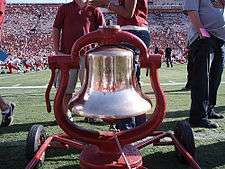
When the football teams from these schools compete against each other, the victor is awarded the Victory Bell. The Victory Bell was originally from an old Southern Pacific railroad locomotive. It was given to the UCLA student body by the UCLA Alumni Association in 1939.
It was UCLA's symbol of victory until it was stolen by a USC organization called the Trojan Knights in 1941. After being hidden in various locations for over a year before resurfacing in a USC student magazine (known as the Wampus), a prank war between the two universities ensued until 1942, when the student body presidents of the two schools agreed that the bell would be the trophy awarded the winner of the annual UCLA-USC football game.
The bell itself is brass, and the metal mounting around it is painted blue or cardinal by the school that won the football game and earned its possession. When UCLA possesses it, the UCLA Rally Committee is responsible for its protection and care. While it is in USC's possession, the Trojan Knights are responsible for hiding, protecting, and showcasing the bell (including ringing the bell during home football games). USC currently has the victory bell.
Rose Bowl
Until the Rose Bowl Game became part of the Bowl Championship Series (BCS) and later the College Football Playoff (CFP), a berth in the Rose Bowl to face the Big Ten Conference champion was the ultimate goal that was awarded to the then-Pacific-10 conference champion. Through the 2016 season, USC has appeared in the Rose Bowl 34 times and UCLA has appeared 12 times. During the BCS era (1998–2013), the Rose Bowl was the destination for the first-place Big Ten and Pac-12 teams, should either fail to qualify for the BCS championship game. Since the establishment of the CFP in 2014, the Rose Bowl is one of six bowls that rotates as host of a CFP semifinal game; in years in which the Rose Bowl does not host a CFP semifinal, the Rose Bowl Game is assured of hosting the first-place teams from the two conferences should they fail to be selected for the CFP semifinals.
UCLA was the first Pac-10 team to appear in a BCS bowl, the 1999 Rose Bowl, their last conference championship year. USC has appeared in six BCS bowl games, winning the BCS championship in 2005. With the Rose Bowl stadium being the home field for UCLA, the UCLA–USC rivalry football game has been played there to a sellout crowd during even numbered years since 1982.
Before the Pac-10 expanded in 2011 and became the Pac-12, the Rose Bowl and conference championship were on the line for both teams 20 times and at least one team 37 times. Following expansion and the division of the conference into two football divisions, with UCLA and USC both in the South Division, the division title and a berth in the Pac-12 Championship Game have been on the line for at least one team twice. Both teams have either won the championship or spoiled it for the other at one time or another.
Football series record
As of the 2017 season, USC leads 49–31–7 (record includes 2 USC wins vacated due to NCAA penalty for violation of NCAA rules).[24][25] There has been one overtime game in the series in 1996. Many of the games of this rivalry have ultimately determined the Pac-10 Rose Bowl representative and often a chance to play for the national championship. USC was forced to vacate both its wins from the 2004 and 2005 seasons due to NCAA violations.[24][26]
| UCLA victories | USC victories | Ties | Forfeits / Vacated wins |
| |||||||||||||||||||||||||||||||||||||||||||||||||||||||||||||||||||||||||||||||||||||||||||||||||||||||||||||||||||||||||||||||||||||||||||||||||||||||||||||||||||||||||||||||||||||||||||||||||||||||||||||||||||||||||||||||||||||||||||||||||||||||||||||||||||||||||||||||||||||||||||||||||||||||||||||||||||||||||||||||||||||||||||||||||||||||||||||||||||||||||||||||||||||||||||||||||||||||||||||||||||||||||||||||||||||||||||||||||||||||||||||||||||||||||||||||
Winning streaks in the series
UCLA holds the longest winning streak in the series, as UCLA won eight straight games from 1991 to 1998. USC's longest streak was for seven wins from 1999 to 2005. But the 7 game winning streak is not recognized because multiple years have vacated wins.
The 1967 "Game of the Century"
The 1967 USC vs. UCLA football game was one of the historically significant football games of the 20th century. It matched No. 4 USC with O.J. Simpson against No. 1 UCLA with Gary Beban for the Conference Championship, National Championship, and Heisman Trophy on the line for Beban or Simpson. USC won 21–20 and went on to defeat Indiana in the Rose Bowl and win the national championship. Despite Simpson's sensational performance in this game and accumulating 1,543 rushing yards for the season, Beban won the Heisman Trophy. Simpson won the trophy the following year.
Other notable games
- In the 1929 season, UCLA would play football in the Pacific Coast Conference for the first time. USC had just come off an undefeated National Championship season under the legendary Howard Jones. In the opening game of the season, the USC "Thundering Herd" defeated UCLA 76–0, which stands as the most lopsided score of the series.[27]
- 1939 season – This was the first year where the Rose Bowl was on the line for both teams, and the first time both teams were ranked. The game ended in a scoreless tie, and USC went to the 1940 Rose Bowl.[28]
- 1952 season – UCLA was ranked #3 and USC was ranked #4. Both teams were undefeated and untied. USC would win on 14–12. USC would later go on to lose to Notre Dame but win the 1953 Rose Bowl.
- 1963 season - The game, scheduled for November 23, was postponed on account of the assassination of John F. Kennedy, which occurred on Friday, November 22. It was played on November 30, with USC prevailing 26–6.[29]
- 1965 season #7 UCLA met #6 USC for the AAWU (Pac-8) title and the right to meet undefeated and #1 Michigan State in the 1966 Rose Bowl. The 1965 "Gutty Little Bruins" team won 20–16 with a score at 2:39 left to play.[30]
- 1969 season – Undefeated #6 UCLA (8–0–1) met undefeated #5 USC (8–0–1) with the 1970 Rose Bowl on the line. USC would prevail with a score in the final two minutes to win 14–12.
- 1976 season – This was one of the biggest games of the 1976 season. Undefeated #2 UCLA (9–0–1) vs. #3 ranked USC (8–1) met to determine the 1977 Rose Bowl representative, and an outside shot at the National Championship should #1 ranked Pittsburgh lose. USC won 24–14 in the first rivalry game for both John Robinson and Terry Donahue.
- 1986 season – Just before halftime, UCLA is up 24–0 over USC. A fake kneel down followed by a hail mary into the end zone put UCLA up 31–0 over USC at halftime. This play was known as "Hail Mary, and In Your Face". UCLA won the game 45–25.
- 1988 season – Undefeated second-ranked USC (9–0) and quarterback Rodney Peete met 9–1, sixth-ranked UCLA and quarterback Troy Aikman with the 1989 Rose Bowl on the line. UCLA had been ranked #1 before losing to Washington State. A possible Heisman trophy for Peete or Aikman was on the line. The attendance set a regular season Rose Bowl record of 100,741. Rodney Peete was stricken with measles the week before the game and had been to the hospital. But he managed to lead the Trojans over the Bruins 31–22. It would set up the classic #1 Notre Dame vs #2 USC matchup the following week. Peete and Aikman would finish 2nd and 3rd in the Heisman balloting behind Barry Sanders.
- 1999 season – USC won 17–7 to break the Bruins' streak of eight straight.
- 2005 season – USC had been ranked #1 all season and faced a one-loss eleventh ranked UCLA (9–1) team as its last obstacle to the dream 2006 Rose Bowl BCS Championship matchup with #2 Texas. USC featured Heisman trophy winner Matt Leinart and eventual winner Reggie Bush. USC defeated UCLA 66–19 in one of the most lopsided games of the series since the first matchup in 1929.[31] The win was later vacated for NCAA infractions.
- 2006 season – "13–9"; on December 2, 2006, UCLA defeated the Trojans, 13–9. In doing so, the Bruins not only ended No. 2-ranked USC's 63-game streak of scoring 20-plus points per game, but also eliminated the Trojans' from competing in their fourth-consecutive national title game (after winning the 2003 and 2004 AP National Championships and narrowly losing to Texas in the 2005 BCS National Championship game), which would have pitted the No. 2 Trojans against No. 1 ranked Ohio State in the 2006 BCS National Championship game. This was only the second USC loss to a major rival (UCLA or Notre Dame) in the Pete Carroll era.
- 2011 season – "50–0"; on November 26, 2011, USC routed UCLA 50–0, which is the largest margin of victory in the rivalry since the 1930 matchup. Quarterback Matt Barkley set the record for passing yards (423) and touchdowns (6) in the history of the rivalry, while wide receiver Marqise Lee set the record for receiving yards (224). The game marked USC's 12th victory in 13 years against UCLA.[32]
Rivalry glory years
Between 1965 and 1978, the conference championship and Rose Bowl berth were on the line for both teams nine times.
- 1965 #7 UCLA uses two late touchdowns sandwiched around an on-side kick to beat #6 USC, 20–16.
- 1966 #8 UCLA, playing without injured star QB Gary Beban, beats #7 USC, 14–7.
- 1967 #2 USC, led by O.J. Simpson's 64-yard TD run and three blocked kicks, beats #1 UCLA, 21–20.
- 1969 #5 USC, after a penalty on a 4th & 10 incompletion, scores a controversial late TD to beat #6 UCLA, 14–12.
- 1972 #1 USC pulls away in the 2nd half to beat #14 UCLA, 24–7. UCLA was led by quarterback Mark Harmon, future television and movie actor.[33]
- 1973 #9 USC, taking advantage of numerous turnovers, beats #8 UCLA, 23–13.
- 1974 #8 USC wins easily over an injury riddled unranked UCLA squad, 34–9.
- 1976 #3 USC, behind the scrambling and passing of QB Vince Evans, beats #2 UCLA, 24–14.
- 1978 #5 USC runs out the last 6½ minutes of the clock to hold off #14 UCLA, 17–10.
In two other years (1975 and 1977) between 1965 and 1978, the Rose Bowl berth was on the line for UCLA only.
- 1975 #14 UCLA overcomes 8 lost fumbles and holds off unranked USC, 25–22 and goes on to upset #1 Ohio State in the Rose Bowl
- 1977 #17 UCLA loses on a last-second USC field goal, 29–27; thus, Washington goes to the Rose Bowl and upsets Michigan.
The USC coaches during this time were John McKay and John Robinson, while UCLA was coached by Tommy Prothro, Pepper Rodgers, Dick Vermeil, and Terry Donahue.
Basketball
Men's
UCLA has 31 conference championships and USC has seven. When John Wooden became the coach, UCLA turned into a national basketball powerhouse. UCLA has won 11 NCAA Men's Division I Basketball Tournaments and has dominated the conference, winning two games for every one that USC won. As of the 2013–2014 season, UCLA has won or shared the conference title 31 times, and USC has won or shared the title 9 times.[34] There have been some notable games in the rivalry.
- The first official meeting between the two schools as they are now known took place in February 1928 after UCLA was invited to join the Pacific Coast Conference. UCLA won two of a three-game basketball series to inaugurate the basketball rivalry.
- USC had a 41-game winning streak against UCLA from 1932 to 1943, a national record that stood until UCLA eventually beat it in 1980 with a 42nd consecutive win against Cal, on the way to a 52-game winning streak, the current NCAA record of one opponent over another.[35] UCLA Defeated USC 42–37 in the first of the two final home games in the 1943 season to break the streak.[36] This is still the third-longest streak of one Division 1 opponent against another.
- In the 1960–1961 season, USC and UCLA met for the third time on March 3, 1961 in the game that would ultimately decide the AAWU champion and 2nd place. The teams had split the two previous games. USC beat UCLA 86–85 in overtime, and later advanced to the NCAA tournament.
- In the 1968–1969 season, USC took UCLA, led by Lew Alcindor, to two overtimes before losing 61–55 at the Los Angeles Sports Arena. On the second game, one night later on March 8, 1969, USC would finally defeat UCLA 46–44, marking the Bruins' first loss in Pauley Pavilion.
- In the 1970–1971 basketball season, UCLA and USC were ranked #1 and #2 for much of the season. #2 ranked USC coached by Bob Boyd suffered its first loss against #3 ranked UCLA, blowing a 9-point second half lead. In the rematch in the final game of the season, UCLA jumped out to a big early lead and went on to win 72–63. USC would finish the season 24–2 and ranked #2, but only the conference champion, UCLA, could be invited to the 1971 NCAA Men's Division I Basketball Tournament, as there were no at-large slots in the bracket. This would be one of the cases for expanding the bracket to 32 teams for the 1975 NCAA Men's Division I Basketball Tournament.
- In the 1973–1974 basketball season, the two teams were tied for first in the Pac-8 going into the last game of the season. With the conference championship and berth in the 1974 NCAA Men's Division I Basketball Tournament on the line, Bill Walton led UCLA to a lopsided victory. Notably, UCLA would be the national semi-finalist in the NCAA tournament, while USC would be the semi-finalist in the Collegiate Coaches' Association Tournament, a tournament that invited second-place conference teams.
- In the 1984–1985 season, UCLA and USC would meet for the game that would decide first place in the Pacific-10. USC already had beat UCLA 78–77 in double overtime at the Los Angeles Memorial Sports Arena. The second game at Pauley Pavilion on February 28, 1985 was finally decided in quadruple overtime with USC winning 80–78. USC would be invited to the 1985 NCAA Men's Division I Basketball Tournament, while UCLA was invited to and won the National Invitation Tournament.
- In the 2007–2008 season, UCLA and USC met in the 2008 Pacific-10 Conference Men's Basketball Tournament, for the first time in 225 games in post-season play. The teams had split in the regular season with the Trojans winning at Pauley Pavilion and the Bruins winning at Galen Center. In their third game, a capacity crowd of 18,997 at the Staples Center saw UCLA beat USC 57–54 in the semi finals.[37] Both teams had highly regarded freshmen: Kevin Love and O. J. Mayo. USC later had to vacate the regular season win when it was found that Mayo had accepted gifts from agents while still in high school, which made him ineligible for NCAA play.
Women's
In Women's basketball, UCLA has one AIAW championship and USC has two NCAA Women's Division I Basketball Championships. USC won its second title, in 1984, at UCLA's Pauley Pavilion. The Bruins and the Women of Troy have faced each other twice in the second round of the AIAW championships with UCLA winning in 1979 and USC winning in 1981.
Other notable sports rivalries
Because of the geographical proximity and conference affiliation, UCLA and USC compete in other NCAA sanctioned sports, such as Basketball, Track and Field, Volleyball, and Water Polo. UCLA and USC are #1 and #3 respectively in terms of the most NCAA championships won in Division I as of 2007.[38] They have faced each other for the national title in several sports including Men's Volleyball and Women's water polo. Although basketball and football tend to get the most attention, the rivalry between the two schools is intense in every sport.
Baseball
The athletic rivalry began in 1920 when the University of California, Southern Branch Cubs defeated USC in spring baseball 7–6.[39] USC has gone on to be the premier team in college baseball with 21 appearances in the College World Series and 12 titles, the most of any school and double the next closest school, Texas, who has six titles in 34 appearances. UCLA has appeared in the College World Series five times. UCLA won its first NCAA Baseball title in 2013.
As of the end of the 2014 season, USC leads UCLA in the series 256–130.[40] Since 2010, UCLA and USC have met in the second game of a college baseball doubleheader at Dodger Stadium called the Dodgertown classic as well as a three-game conference series.[41]
Fencing
Both the USC Fencing Club and UCLA fencing club are in the Intercollegeiate Fencing Conference of Southern California (IFCSC). They compete against NCAA fencing teams as well, such as UCSD, Caltech, and ASU.[42][43][44]
Soccer
UCLA women's soccer team has dominated the Women of Troy, 22–5–1. But at the 2007 NCAA College Cup, USC won in the semi-finals, ended UCLA's 8 straight victories over the Trojans. USC went on to be the first Pac-10 (as it was called at the time) school to win the NCAA Women's Soccer Championship. In the 2008 regular season game, a pair of goals by Kristina Larsen gave UCLA a 2–1 win over USC in the Los Angeles Coliseum before a record crowd of 7,804 fans.
To advance to the NCAA Championship quarterfinals, the Bruins defeated the Women of Troy (1–0) in the round of 16 on Saturday, November 22, 2008 at Drake Stadium. It was also a battle between UCLA's Lauren Cheney and Kara Lang and USC's Amy Rodriguez, all of whom participated in the Beijing Olympic Games—Cheney and Rodriguez for the USA and Lang for Canada. Cheney and Rodriguez would win gold medals with Team USA, defeating Lang's Canada team in the quarterfinals. UCLA won the NCAA Division I Women's Soccer Championship in 2013, defeating Florida State 1–0 in overtime.
Tennis
As of the 2014 season, USC has won 21 NCAA Men's Tennis Championships and UCLA has won 16. USC has won 5 of the last 6 (2009–2012, 2014), while UCLA's most recent Championship was in 2005. There was a run from 1960 to 1971 where either UCLA or USC was the champion. In twelve of the tournaments, one team has been runner-up to the other who won the championship, with an even split of six championships for both UCLA and USC.
UCLA has won two NCAA Division I Women's Tennis Championships, most recently in 2014. USC won in 1983 and 1985.
Volleyball
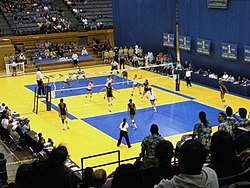
UCLA has dominated men's volleyball under the coaching of Al Scates. As of 2013, UCLA has won 19 NCAA Men's Volleyball Championships. The next closest school is Pepperdine with five NCAA titles. USC has won four NCAA titles. UCLA and USC have faced each other in the championship game of the NCAA Men's Volleyball Championship four times.
- 1979 UCLA 3–1 USC
- 1980 USC 3–1 UCLA
- 1981 UCLA 3–2 USC
- 1987 UCLA 3–0 USC
In women's volleyball, UCLA won the 2011 national Championship. UCLA now has won four and USC has won three NCAA Women's Volleyball Championships in Division I. In addition, USC and UCLA have won three AIAW Women's volleyball championships.
In 1981 USC defeated UCLA three games to two in the first NCAA Women's Volleyball Championship game. In 1976 USC defeated UCLA to win the AIAW volleyball championship.
Water polo
The two schools compete in water polo. In men's, UCLA carries a slight lead over USC in the all-time series of 80–76–1. In the NCAA Men's Water Polo Championship, the two school are tied with 9 championships apiece. UCLA won the most recent championship in 2014, with USC winning the prior 6 titles dating back to 2008. Due to the low number of schools participating in the sport and the State of California's dominance (no team from outside of California has ever played in the championship match), title game matches between the two teams are relatively common, occurring in 1996, 2009, 2012, and 2012. In title game matches, USC holds a 3–2 advantage. UCLA won 8–7 in 1996, and 9-8 in 2014, while USC won 7–6 in 2009, 7-4 in 2011, and 11-10 in 2012.
In women's water polo, UCLA has a commanding 46-22 lead over USC in the all-time series. In the NCAA Women's Water Polo Championship, UCLA dominated early on, winning 7 of the first 9 NCAA Championships, including the first tournament in 2001. USC has won 4, most recently in 2016. The two teams have faced each other in the women's title game 3 times, in 2006, 2008, and 2009. UCLA won all 3 matches by scores of 9–8, 6–3,[45] and 5–4, respectively. All three wins were part of UCLA's streak of 5 consecutive championships.
Head-to-head records by sport
As of December 18, 2014, USC leads the all-time all-sport record 967–922–10.[46]
Men's
- Baseball: USC 256–130
- Basketball: UCLA 138–105
- Football: USC 46–31–7
- Tennis: UCLA 105–90
- Track & Field: USC 42–39
- Volleyball: UCLA 90–41
- Water Polo: UCLA 80–76–1
- Gymnastics: UCLA 9–7
- Soccer: UCLA 13–3
- Swimming: USC 67–13
Women's
- Basketball: USC 47–39
- Cross Country: UCLA 1–0
- Rowing: USC 13–0
- Sand Volleyball: USC 3–0
- Soccer: UCLA 22–5–1
- Swimming: USC 24–16
- Tennis: UCLA 50–47
- Track & Field: UCLA 22–9
- Volleyball: UCLA 60–56
- Water Polo: UCLA 46–22
- Gymnastics: UCLA 16–10–1
Italic sports are inactive due to one of both schools discontinuing the sport
Note: This record includes all games played in active sports, but does not include every inactive sport.
Olympic athletes
Both UCLA and USC send many athletes to the Olympic Games. As of the last games, USC athletes account for 258 medals and UCLA athletes account for 241. A USC Trojan has been a Gold medal winner in every summer Olympics since 1912. As of the 2008 Summer Olympics, UCLA and USC athletes combined account for nearly one fifth of all medals won by the United States of America and their 499 combined medals would rank 9th on the country list.[47] [48] [49] [50]
Rivalry outside sports competition
| Category | USC | UCLA |
|---|---|---|
| Location | Los Angeles, CA | Los Angeles, CA |
| Ownership | Private university | Public university |
| Founded | 1880 | 1919 |
| Students | 40,000 [51] | 42,163 [52] |
| School colors | Cardinal and gold | True Blue and gold |
| Nickname | Trojans | Bruins |
| Football stadium | LA Coliseum | Rose Bowl |
| Basketball arena | Galen Center | Pauley Pavilion |
| Annual tuition | $52,283 [53] | $12,692 Calif Resident
$35,570 (non-resident)[54] |
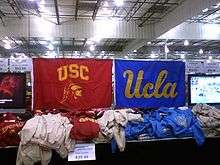
The UCLA–USC rivalry is like few other college or university rivalries. Both universities are in the same city. Both universities are at the top in the nation not only for their sports achievements, but also for academic standing. While UCLA historically has been viewed as the more selective institution, USC has made great strides in improving its position in university rankings. Graduate schools at both universities are among the top in their fields. Furthermore, graduates from both universities work together all across Southern California. It is not uncommon for married couples or family members to consist of graduates from each school. Undergraduates of one school can be found attending graduate school and/or professional school across town. High schools in Southern California send some of their top graduates to both schools every year, as do community colleges around Los Angeles. Students from each school, including athletes, even can be found rooming together in the same house or apartment in Los Angeles.
The rivalry is also a microcosm of a geopolitical rivalry based upon the locations of the schools, the cost of attending each school, and the founding and growth patterns of the schools.
Geographic location
UCLA is located on the Westside of Los Angeles and is nestled between many several of the most affluent and desirable communities in southern California: Brentwood, Bel-Air, Beverly Hills and Westwood. Although this area was relatively remote and unsettled at the time of UCLA's founding, decades of growth in the area around campus means that UCLA is hardly the suburban location it once was.
In 2012, Bruins football coach Jim Mora said he sold recruits on the safety of UCLA's campus location. "I mean, we don't have murders one block off our campus," said Mora. He denied he was making a reference to USC, which months earlier had two of their students killed near campus.[55]
USC, by contrast, is located on the Southern fringe of downtown Los Angeles by Exposition Park. In the early years of the city, it was a fashionable area, but it began to be rundown as wealthier residents migrated towards other suburban neighborhoods, following the national trend. USC was an isolated enclave for a number of years and the surrounding neighborhood had a bad reputation. Lately, with newer downtown construction, the area is becoming connected with downtown again, although the neighborhood remains marginal. Most of the major LA area public sports facilities are located near campus, including the Los Angeles Coliseum and Staples Center.
Funding and cost of attendance
The University of California is a public university, while the University of Southern California is a private university. As a public university, UCLA offers discounted attendance rates for California residents. For 2009–10 the estimated cost of attendance (tuition, fees, room, board, books, etc.) at UCLA is approximately $30,476 for in-state students living on campus, compared to $53,354 for out-of-state students, also living on campus.[56]
At USC, no differentiation in fees is made between California residents and those coming from out-of-state. USC estimates the cost of attendance for all students living on campus for the 2009–10 school year at about $60,801 [57]
The University of California System has raised fees on all its campuses, including at UCLA, over the years to account for declines in state support and to keep pace with inflation.[58]
Costs of attendance at both UCLA and USC may be off-set by financial aid, in the form of loans or grants based on merit or need or both. This includes athletic scholarships.
Founding
USC was established in 1880. UCLA was founded in 1919 when California Gov. William D. Stephens signed California Assembly Bill 626, establishing the Southern Branch of the University of California. UCLA moved to its current location in 1927 when it was renamed the University of California at Los Angeles. USC had been playing football since 1888 and joined the Pacific Coast Conference in 1922. UCLA started playing football in 1919 and joined the PCC in 1928.
UCLA-USC rivalry in popular culture
- On the Jack Benny NBC radio program from November 26, 1950 (the Sunday after that season's UCLA – USC game), the episode was about Jack trying to go to the game with Mary Livingstone and Dennis Day.[59] Jack also had the USC and UCLA coaches as guests on his television show.
- The Sports Illustrated Swimsuit Issue in 1989 is the magazine's top-selling issue of all-time.[60] On page 225 is a photo of a UCLA student posing in a bikini in her bedroom, while in the background are a Bruin bear wearing a button with a four-letter expletive directed at USC, "Fuck SC", and a poster underneath that says "My Two Favorite Teams are the BRUINS and Whoever Is Playing USC."[61][62][63] The St. Petersburg Times brought the picture to the magazine's attention. Sports Illustrated managing editor Mark Mulvoy responded, "You're the first person to tell me this. Twenty million people have read that issue and no one noticed it. We did not do it on purpose. This was not an attempt to sneak the word into Sports Illustrated. I regret it."[61] The Register-Guard wrote that the magazine was accustomed to criticism for Swimsuit Issue photos being too revealing. The newspaper published an accompanying photo of the magazine cover with the caption, "The SI cover was OK, but page 225 wasn't".[64]
- In a 2005 ESPN commercial, a man wearing a UCLA sweatshirt opens his door on Halloween to find a young Trick-or-treater dressed in a Trojan outfit. He closes his door in disgust without handing out any candy. (The commercial's comedy lies in the fact that UCLA and USC fans retain a lifetime rivalry with each other, while still living side-by-side.)
- In a 2006 episode of The New Adventures of Old Christine, Old Christine's ex-husband, Richard, takes their son Richie to the UCLA-USC game at the Coliseum.
See also
- UCLA Bruins athletics
- USC Trojans athletics
- 1967 USC vs. UCLA football game
- Game of the Century (college football)
- SoCal BMW Crosstown Cup
- List of NCAA schools with the most NCAA Division I championships
Other Pac-12 football rivalries
- Apple Cup – Trophy for the Washington / Washington State football game
- Civil War – Oregon / Oregon State football game
- Big Game – Stanford / California football game
- Rumble in the Rockies – Colorado / Utah football game
- Territorial Cup – Trophy for the Arizona / Arizona State football game
Notes
- ↑ http://fs.ncaa.org/Docs/stats/champs_records_book/Overall.pdf
- ↑ "USC clinches Gauntlet Trophy over UCLA", Fox Sports West, April 25, 2011
- ↑ "USC wins 4th straight Gauntlet title", Pedro Moura, ESPN.com, April 25, 2011
- ↑ "http://www.usctrojans.com/genrel/043012aaa.html", University of Southern California, April 30, 2012
- ↑ "http://www.bruinsnation.com/2012/5/1/2991099/UCLA-USC-Gauntlet-Trophy-Fire-Dan-Guerrero-Gene-Block", May 1, 2012
- ↑ "UCLA Athletics on Twitter". Twitter.
- 1 2 3 4 5 6 Pac-10 football media guide. Pacific-10 Conference, Fall 2008. PDF copy available at http://www.pac-12.org
- ↑ "1928 UCLA Bruins Schedule and Results". Sports-Reference/College Football. Archived from the original on October 5, 2015. Retrieved December 17, 2015.
- ↑ Dyer, Braven (September 28, 1929). "Trojans and Bruins Open Grid Season Today – Rivals Primed for First Tilt – Expect Crowd of 35,000 Fans to Watch Teams Three New Faces on Jones's First Line-up – Bruins Have Only Outside Chance to Win". Los Angeles Times.
In years to come, this game will probably be one of the football spectacles of the West
- ↑ The Start of Something Big: USC vs. UCLA by Lonnie White, marking 75 years of the UCLA-USC rivalry
- ↑ Burke, Anne (Editor) – Summer 2004 Bruin Walk: Rah-rah Boo-hiss. UCLA Magazine, summer 2004
- ↑ White, Lonnie – THE RIVALRY: UCLA VS. USC – It could turn into a special moment. Xs and O's A look at a key matchup inside the USC-UCLA football game. Today: The special teams. Los Angeles Times, November 30, 2006.
- ↑ Mozingo, Joe (November 14, 2000). "UCLA Band Instruments Stolen at USC". Los Angeles Times.
- ↑ Hersch Jamie, A SEASON IN THE STANDS: UCLA VS. USC (MANAGERS!) The guys behind the guys go at it during Rivalry Week. ESPN A Season in the Stands, December 5, 2008
- ↑ Klein, Gary It's City Limited Los Angeles Times, December 04, 2010 Note: Brian Wagner passed for three touchdowns this week as USC's student football managers defeated UCLA's managers, 21–7, at UCLA. USC extended its winning streak in the series to three games.
- ↑ Klein, Gary – USC brass is surprised at UCLA's uniform plans for football game. Los Angeles Times, November 23, 2011. Note: UCLA defeated USC, 57–55, in triple overtime Tuesday night in the annual flag-football game between student football managers.
- ↑ http://www.werunthecity.com
- ↑ "USC and UCLA Competition Draws Blood".
- ↑ Chris Foster, UCLA sticks it to USC over midfield logo-stabbing tradition, Los Angeles Times, November 13, 2012
- ↑ NCAA Football rules 2006 (PDF)
- ↑ USC willing to give up timeout to wear cardinal at UCLA ESPN.com news services, December 2, 2008
- ↑ Klein, Gary – USC is right at home on rivals' turf. Los Angeles Times, December 7, 2008
- ↑ Rogers Redding, Secretary-Rules Editor, NCAA Football Rules Committee – NCAA Football 2009–10 Rules and Interpretations. The National Collegiate Athletic Association, May 2009. Article 3. a. Players of opposing teams shall wear jerseys of contrasting colors. Players on the same team shall wear jerseys of the same color and design. 1. The visiting team shall wear white jerseys; however, the home team may wear white jerseys if the teams have agreed in writing before the season. 2. If the home team wears colored jerseys, the visiting team may also wear colored jerseys, if and only if the following conditions have been satisfied: (a) The home team has agreed in writing prior to the game (b) The conference of the home team certifies that the jersey of the visiting team is of a contrasting color.
- 1 2 2010 USC Football. USC Sports Information Office. 2010. p. 2. Archived from the original (PDF) on January 30, 2011. Retrieved January 30, 2011.
The USC football program is on probation until June 9, 2014 for NCAA violations involving agent and amateurism issues, lack of institutional control, impermissible inducements, extra benefits, exceeding coach staff limits and unethical conduct. The penalties include: public reprimand and censure; four years of probation through June 9, 2014; post-season ban for the 2010 and 2011 seasons; one-year show cause penalty (through June 9, 2011) for an assistant football coach; vacation of wins from December 2004 through the 2005 season; limit of 15 initial scholarships and 75 total scholarships for each of the 2011– 12, 2012–13 and 2013–14 years; $5,000 fine; disassociation of a former football player; prohibit non-university personnel from traveling on team charters, attending practices and camps, and having access to sidelines and locker rooms. USC is appealing selected penalties.
- ↑ "2011 UCLA Football Media Guide". pp. 62, 68. Archived from the original (PDF) on December 4, 2011.
- ↑ USC ordered to vacate wins, gets bowl ban, docked 30 scholarships. June 10, 2010.
- ↑ Dyer, Braven (September 29, 1929). "Trojans Batter Bruins by 76 to 0 Score – Herd Hangs Up 12 Touchdowns – Flashy Backs Run Wild, Over Weak Rival Line Saunders, Shaver Cut Loose With Long Gallops Musick Looms as Real Star in Fullback Berth". Los Angeles Times.
- ↑ Troy, Tennessee in Rose Bowl. Los Angeles Times, December 10, 1939. It will be Southern California and Tennessee in the Rose Bowl Jan. 1, 1940.
- ↑ Katz, Greg (November 20, 2014) "Nov. 22 brings haunting memories to Baby Boomer generation." ESPN USC Trojans Blog. (Retrieved 22-20-2014.)
- ↑ UCLA Athletics: 1964–1965 UCLA.edu
- ↑ Leon Moore, David (December 3, 2005). "L.A. is capital of football for a day". USA Today. Retrieved May 26, 2010.
- ↑ Chris Dufresne, A freakish Friday lifts UCLA into Pac-12 title game, Los Angeles Times, November 25, 2011
- ↑ http://pac-12.com/article/2011/05/16/ucla-ncis-mark-harmon-still-quarterback
- ↑ 2007–08 PAC-10 Men's Basketball Media Guide
- ↑ 2008–09 NCAA Men's Basketball Records (ncaa.org) p58, Rivalries, Consecutive victories
- ↑ Dyer, Braven – The Sports Parade. Los Angeles Times, March 9, 1943
- ↑ No. 3 UCLA Advances to Pac-10 Championship Game With 57–54 Win. UCLA Athletic Department, March 14, 2008
- ↑ Schools with the most NCAA championships (ncaa.org, link no longer exists) as of Spring 2009. Abstract: The NCAA does not award National Championships in Division I-A football. See the Wikipedia article NCAA Division I-A national football championship for more information. The NCAA numbers leave out USC's 11 football championships from their tally of 88. Stanford University is in second place with 96 NCAA championships and two football championships. UCLA has 105 NCAA championships and 1 football championship. The next closest school is Oklahoma State with 48 NCAA championships. UCLA and USC also have AIAW titles, and titles awarded before the advent of the NCAA.
- ↑ Ben Bolch. UCLA-USC friction goes beyond football. Los Angeles Times. November 27, 2007. Quote:UCLA-USC has been a back-and-forth affair since the schools first met in a major sport in the spring of 1920, when the Bruins – then known as the Southern Branch Cubs – knocked off the Trojans in baseball, 7–6, at Exposition Park.
- ↑ Note: The 2013 UCLA Baseball (copy available from www.uclabruins.com) media guide only lists game by game results going back to 1955. Previously, the 2007 UCLA Baseball media guide listed results back to 1975. The 2007 USC Baseball media guide (Copy available from www.usctrojans.com) states: "*All game-by-game records before the 1921 season are unavailable." One very interesting note is that the 2007 USC Baseball media guide confuses UCSB as University of California, Santa Barbara when it should be University of California, Southern Branch, the old name for UCLA. Santa Barbara State College did not become UCSB until 1947, at which time the UCSB Baseball media guide season-by-season results start.
- ↑ Gurnick, Ken – Dodger Stadium to host college baseball. mlb.com, January 29, 2010
- ↑ www.ifcsc.org
- ↑ UCLA Fencing
- ↑ USC Fencing Homepage
- ↑ UCLA Defeats USC, 6–3, To Win Fourth-Straight NCAA Title. Women's water polo goes undefeated to win UCLA's 101st NCAA championship. UCLA Athletic Department, May 11, 2008.
- ↑ http://ucla-usc.com/. Retrieved June 4, 2014; updated December 18, 2014, to reflect results through the fall 2014 season. Check date values in:
|accessdate=(help); Missing or empty|title=(help) - ↑ "UCLA vs. USC Athletic Departments". great-sports-rivalries.com. Retrieved December 5, 2011.
- ↑ USC Olympians from the USC official Athletic site (PDF)
- ↑ UCLA Olympic medalists from the UCLA official athletic site
- ↑ "Olympic medals by country (Olympic.it)".
- ↑ "Facts and Figures — About USC".
- ↑ "Quick Facts — UCLA Undergraduate Admission".
- ↑ https://www.collegedata.com/cs/data/college/college_pg03_tmpl.jhtml?schoolId=1138. Missing or empty
|title=(help) - ↑ "Fees, Tuition, and Estimated Student Budget — UCLA Undergraduate Admission".
- ↑ Yoon, Peter (August 10, 2012). "Jim Mora discusses campus safety". ESPN.com. Archived from the original on August 10, 2012.
- ↑ "UCLA Fees, Tuition, and Estimated Student Budget".
- ↑ "USC Estimated Cost of Attendance".
- ↑ Excerpt from 2007–08 Budget for Current Operations Appendix A Student Fees(PDF document)
- ↑ "IIS Windows Server".
- ↑ Matshushita, Elaine (April 19, 2008). "Kathy Ireland: From bikinis to bedding". Chicago Tribune. Archived from the original on October 11, 2011.
- 1 2 "Morning Briefing: No Matter What, Beware of the Fine Print". Los Angeles Times. February 13, 1989. Archived from the original on 2010-11-14. Retrieved 2010-11-15.
On a shelf to her left is a small Bruin bear wearing a button. The first two lines are illegible, but the bottom two are an expletive directed at USC.
- ↑ Merron, Jeff (February 21, 2003). "SI undressed". ESPN.com. Archived from the original on March 6, 2015.
- ↑ Newman, Bruce (February 7, 1989). "Up Against The Wall". Sports Illustrated. p. 225. Archived from the original on September 10, 2017.
- ↑ "It was way too revealing". The Register-Guard. February 14, 1989. p. 2D. Retrieved October 11, 2011.
Further reading
- White, Lonnie – The Start of Something Big: USC vs. UCLA. Marking 75 years of the UCLA–USC rivalry. USC Trojan Family Magazine, Autumn 2004.
- Clark, Justin – Crosstown Rivals LA Weekly. November 29, 2006. When USC and UCLA put on their academic game faces, nothing less than the future of the city is at stake.
- White, Lonnie (August 2004). UCLA vs. USC: 75 Years of the Greatest Rivalry in Sports. Los Angeles Times Books. ISBN 1-883792-27-4.
- Florence, Mal – The Great Rivalries USC vs. UCLA. Athlon College Football Preview, Autumn 1990
- Colsafe – USC vs. UCLA - Which campus is safer?.

